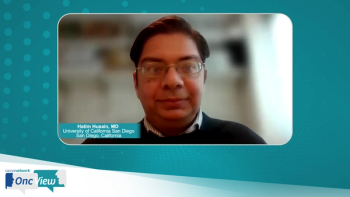
Assessing Risk for Recurrence in Early CRC
Dr. Daniel Ahn discusses the implications of postoperative ctDNA testing for decision-making in early stage CRC.
Episodes in this series

Kristie L. Kahl: Dr Ahn, how would postoperative circulating tumor DNA [ctDNA] testing improve decision-making around the initiation of adjuvant therapy?
Daniel Ahn, DO: In patients with early stage colorectal cancer, I see the potential benefit for postoperative ctDNA testing in 2 potential scenarios. The first scenario is to evaluate the need for adjuvant chemotherapy. This means that in a patient with early stage disease, specifically stage II disease, absent any high-risk clinical pathologic factors for which we would not consider giving adjuvant chemotherapy, if a patient were to test positive or have evidence of minimal residual disease [MRD], we would strongly consider giving adjuvant chemotherapy based on the prognostic association with recurrence. Another potential scenario for the use of ctDNA would be to avoid unnecessary chemotherapy, whether it’s based on a patient’s individual preference or other clinical circumstances, or potentially in surveillance monitoring after the completion of adjuvant chemotherapy or after the completion of definitive therapy.
Kristie L. Kahl: What is the benefit of longitudinal postsurgical circulating tumor DNA surveillance vs relying solely on imaging and CEA [carcinoembryonic antigen] testing? Could this help guide the duration of adjuvant therapy?
Daniel Ahn, DO: The benefit for longitudinal postsurgical ctDNA surveillance compared with solely relying on imaging and CEA has to do with the sensitivity. This means that the detection of tumor-informed ctDNA following surgical resection is a strong predictor for disease relapse, and several observational studies have suggested that it outperforms traditional high-risk clinical pathologic high-risk factors. Additionally, when we think about predicting relapse, it is a better and more sensitive assay compared with our currently used surveillance tools.
Kristie L. Kahl: How would personalized tumor-specific circulating tumor DNA testing differ from the type of tumor testing that we do now? Can you also comment on the sensitivity and specificity of the Signatera test?
Daniel Ahn, DO: I would consider this an additional tool, which would be complementary to ongoing testing that we provide in the surveillance setting, specifically in conjunction with routine blood draws and imaging. However, over the past several years, the concern would be for the use of ctDNA as a surrogate marker for MRD. How sensitive or specific are these assays? Over the past several years, the sensitivity and specificity of these assays have really improved, which allows for the tracking of specific variants in the tumor that reduced the risk for some of the cofounder variables, including CHIP, which is the presence of potential mutations in aging hematopoietic stem cells that can be misinterpreted as being positive for MRD.
The use of a tumor informed ctDNA assay, which is personalized based on the patient’s individual tumor as well as improvements in the specificity of assays, can help eliminate some of these misinterpreted results or some of these false positives. One of the assays that are widely available through commercial use is the signature assay. The way this assay works is by attracting 16 variants, including clonal variants, and it is conducted using ultra-deep sequencing. As a result, the specificity is maximized because it requires 2 variants to be called positive. Also, it also eliminates germline mutations as well as CHIP mutations from the 16-variant tracked and set.
Kristie L. Kahl: What are the clinical implications of earlier identification of molecular progression?
Daniel Ahn, DO: At this time, the clinical implications for the use of MRD through ctDNA analysis are truly prognostic. We know that the positivity of these MRD assays is associated with recurrence and a poor prognosis. Unless we think about specific instances, the results may really help us better determine whether certain patients should be considered for treatment. However, the utility is not predictive currently. This means, that the positivity has not changed the clinical decision-making for most patients.
Transcript edited for clarity.
Newsletter
Stay up to date on recent advances in the multidisciplinary approach to cancer.
















































































